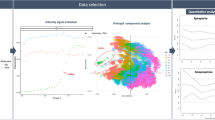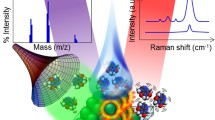Abstract
A unique approach based on Molecular Immobilization and Resonant Raman Amplification by Complex-Loaded Enhancers (MIRRACLE) on copper (II)–chitosan–modified SERS-active metallic nanostructured substrates is proposed for sensitive and rapid determination of the catecholamines (CA) dopamine, norepinephrine, and epinephrine. The ternary (CA)2Cu(4AAP)2 complexes were characterized by the appearance of new absorbance bands at 555, 600, and 500 nm for dopamine, norepinephrine, and epinephrine, respectively. The new absorbance band matched with a broad surface plasmon resonance band of utilized silver nanoparticles: 450–600 nm, and 633 excitation wavelength. We observed enhancement factors up to 3.6·106 due to the additional resonant enhancement. The multiplexing capabilities of quantitative spectral unmixing for Raman spectra of a group of CAs, which differ by only either hydroxy or methyl group, at the fingerprint region were successfully demonstrated with the direct classic least squares model. The achieved nM limits of detection with only 1.5 mW laser power and analysis of spiked human blood plasma samples proved the possibility of the multiplex determination of the catecholamines at the level of reference concentrations in the blood of healthy people as well as promise for the future facilitation in the precision diagnosis of neuroendocrine tumors and neurodegenerative diseases.
Graphical abstract







Similar content being viewed by others
References
Vatsadze SZ, Eremina OE, Veselova IA, Kalmykov SN, Nenajdenko VG (2018) 18F-Labelled catecholamine type radiopharmaceuticals in the diagnosis of neurodegenerative diseases and neuroendocrine tumours: approaches to synthesis and development prospects. Russ Chem Rev 87:350–373
Veselova IA, Sergeeva EA, Makedonskaya MI, Eremina OE, Kalmykov SN, Shekhovtsova TN (2017) Methods for determining neurotransmitter metabolism markers for clinical diagnostics. J Analyt Chem 71:1155–1168
Ribeiro JA, Fernandes PMV, Pereira CM, Silva F (2016) Electrochemical sensors and biosensors for determination of catecholamine neurotransmitters: a review. Talanta 160:653–679
Zhang W, Cao X, Xie Y, Ai S, Jin L, Jin J (2003) Simultaneous determination of the monoamine neurotransmitters and glucose in rat brain by microdialysis sampling coupled with liquid chromatography-dual electrochemical detector. J Chromatogr B 785:327–336
Zhao XE, Suo YR (2008) Simultaneous determination of monoamine and amino acid neurotransmitters in rat endbrain tissues by pre-column derivatization with high-performance liquid chromatographic fluorescence detection and mass spectrometric identification. Talanta 76:690–697
Song P, Mabrouk OS, Hershey ND, Kennedy RT (2012) In vivo neurochemical monitoring using benzoyl chloride derivatization and liquid chromatography-mass spectrometry. Anal Chem 84:412–419
Nirogi R et al (2013) A sensitive and selective quantification of catecholamine neurotransmitters in rat microdialysates by pre-column dansyl chloride derivatization using liquid chromatography-tandem mass spectrometry. J Chromatogr B Analyt Technol Biomed Life Sci 913–914:41–47
Zhao Y, Zhao S, Huang J, Ye F (2011) Quantum dot-enhanced chemiluminescence detection for simultaneous determination of dopamine and epinephrine by capillary electrophoresis. Talanta 85:2650–2654
Kang J, Yin XB, Yang X, Wang E (2005) Electrochemiluminescence quenching as an indirect method for detection of dopamine and epinephrine with capillary electrophoresis. Electrophoresis 26:1732–1736
Zhang L, Qv S, Wang Z, Cheng J (2003) Determination of dopamine in single rat pheochromocytoma cell by capillary electrophoresis with amperometric detection. J Chromatogr B 792:381–385
Baron R, Zayats M, Willner I (2005) Dopamine-, L-DOPA-, adrenaline-, and noradrenaline-induced growth of Au nanoparticles: assays for the detection of neurotransmitters and of tyrosinase activity. Anal Chem 77:1566–1571
Hsu MS, Chen YL, Lee CY, Chiu HT (2012) Gold nanostructures on flexible substrates as electrochemical dopamine sensors. ACS Appl Mater Interfaces 4:5570–5575
Katelhon E, Hofmann B, Lemay SG, Zevenbergen MA, Offenhausser A, Wolfrum B (2010) Nanocavity redox cycling sensors for the detection of dopamine fluctuations in microfluidic gradients. Anal Chem 82:8502–8509
Gong Q-j, Han H-x, Wang Y-d, Yao C-z, Yang H-y, Qiao J-l (2020) An electrochemical sensor for dopamine detection based on the electrode of a poly-tryptophan-functionalized graphene composite. New Carbon Mater 35:34–41
Anuar NS, Basirun WJ, Shalauddin M, Akhter S (2020) A dopamine electrochemical sensor based on a platinum–silver graphene nanocomposite modified electrode. RSC Adv 10:17336–17344
Makedonskaya MI, Veselova IA, Kalmykov SN, Shekhovtsova TN (2018) Novel biosensing system for the simultaneous multiplex fluorescent determination of catecholamines and their metabolites in biological liquids. J Pharm Biomed Anal 156:133–141
Duan H, Li L, Wang X, Wang Y, Li J, Luo C (2015) A sensitive and selective chemiluminescence sensor for the determination of dopamine based on silanized magnetic graphene oxide-molecularly imprinted polymer. Spectrochim Acta A Mol Biomol Spectrosc 139:374–379
Li Y, Peng W, You X (2017) Determination of dopamine by exploiting the catalytic effect of hemoglobin–stabilized gold nanoclusters on the luminol–NaIO4 chemiluminescence system. Microchim Acta 184:3539–3545
Ming L, Peng T, Tu Y (2015) Multiple enhancement of luminol electrochemiluminescence using electrodes functionalized with titania nanotubes and platinum black: ultrasensitive determination of hydrogen peroxide, resveratrol, and dopamine. Microchim Acta 183:305–310
Peng H et al (2019) Facile electrochemiluminescence sensing platform based on water-soluble tungsten oxide quantum dots for ultrasensitive detection of dopamine released by cells. Anal Chim Acta 1065:21–28
Rasheed PA, Lee J-S (2017) Recent advances in optical detection of dopamine using nanomaterials. Microchim Acta 184:1239–1266
Soleymani J (2015) Advanced materials for optical sensing and biosensing of neurotransmitters. TrAC Trends Anal Chem 72:27–44
Sharma B, Frontiera RR, Henry A-I, Ringe E, Van Duyne RP (2012) SERS: Materials, applications, and the future. Mater Today 15:16–25
Eremina OE et al (2018) Surface-enhanced Raman spectroscopy in modern chemical analysis: advances and prospects. Russ Chem Rev 87:741–770
Dumont E et al (2018) Development of a SERS strategy to overcome the nanoparticle stabilisation effect in serum-containing samples: application to the quantification of dopamine in the culture medium of PC-12 cells. Talanta 186:8–16
Jensen L, Aikens CM, Schatz GC (2008) Electronic structure methods for studying surface-enhanced Raman scattering. Chem Soc Rev 37:1061–1073
McNay G, Eustace D, Smith WE, Faulds K, Graham D (2011) Surface-enhanced Raman scattering (SERS) and surface-enhanced resonance Raman scattering (SERRS): a review of applications. Appl Spectrosc 65:825–837
Eremina OE, Sergeeva EA, Ferree MV, Shekhovtsova TN, Goodilin EA, Veselova IA (2021) Dual-purpose SERS sensor for selective determination of polycyclic aromatic compounds via electron donor-acceptor traps. ACS Sens 6:1057–1066
Eremina OE, Kapitanova OO, Goodilin EA, Veselova IA (2020) Silver-chitosan nanocomposite as a plasmonic platform for SERS sensing of polyaromatic sulfur heterocycles in oil fuel. Nanotechnology 31:225503
Bisaglia M, Mammi S, Bubacco L (2007) Kinetic and structural analysis of the early oxidation products of dopamine: analysis of the interactions with alpha-synuclein. J Biol Chem 282:15597–15605
Bisaglia M, Bubacco L (2020) Copper ions and Parkinson’s disease: Why is homeostasis so relevant? Biomolecules 10:195
Nour El-Dien FA, Zayed MA, Mohamed GG, El-Nahas RG (2005) Two spectrophotometric assays for dopamine derivatives in pharmaceutical products and in biological samples of schizophrenic patients using copper tetramine complex and tri-iodide reagent. J Biomed Biotechnol 2005:1–9
Sidorov AV, Eremina OE, Veselova IA, Goodilin EA (2015) Polymer-coated substrates for surface enhanced Raman spectroscopy. Mendeleev Commun 25:460–462
Faris GW, Copeland RA (1997) Wavelength dependence of the Raman cross section for liquid water. Appl Opt 36:2686–2688
Fally S, Carleer M, Vandaele AC (2009) UV Fourier transform absorption cross sections of benzene, toluene, meta-, ortho-, and para-xylene. J Quant Spectrosc Radiat Transfer 110:766–782
Skinner JG, Nilsen WG (1968) Absolute Raman scattering cross-section measurement of the 992 cm^−1 line of benzene*. J Opt Soc Am 58:113–119
Eremina OE, Sidorov AV, Shekhovtsova TN, Goodilin EA, Veselova IA (2017) Novel multilayer nanostructured materials for recognition of polycyclic aromatic sulfur pollutants and express analysis of fuel quality and environmental health by surface enhanced Raman spectroscopy. ACS Appl Mater Interfaces 9:15058–15067
Sidorov A, Vashkinskaya O, Grigorieva A, Shekhovtsova T, Veselova I, Goodilin E (2014) Entrapment into charge transfer complexes for resonant Raman scattering enhancement. Chem Commun 50:6468–6470
Eremina OE et al (2022) Ultrasensitive and multiplex SERS determination of anthropogenic phenols in oil fuel and environmental samples. Environ Sci: Nano 9:964–974
Van Loon GR, Sole MJ (1980) Plasma dopamine: source, regulation, and significance. Metabolism 29:1119–1123
McGrath BP, Ledingham JGG, Benedict CR (1978) Catecholamines in peripheral venous plasma in patients chronic haemodialysis. Clin Sci Mol Med 55:89–96
Umegaki H, Tamaya N, Shinkai T, Iguchi A (2000) The metabolism of plasma glucose and catecholamines in Alzheimer’s disease. Exp Gerontol 35:1373–1382
Meites J (1990) Aging: hypothalamic catecholamines, neuroendocrine-immune interactions, and dietary restriction. Proc Soc Exp Biol Med 195:304–311
Subramaniam R (2011) Pheochromocytoma – current concepts in diagnosis and management. Trends Anaesth Crit Care 1:104–110
Sergeeva EA, Eremina OE, Sidorov AV, Shekhovtsova TN, Goodilin EA, Veselova IA (2016) Bioprotective polymer layers for surface-enhanced Raman spectroscopy of proteins. Mater Technol 32:881–887
Acknowledgements
This research has been supported by the Interdisciplinary Scientific and Educational School of Moscow University «Future Planet: Global Environmental Change». The research was carried out using the equipment of MSU Shared Research Equipment Center “Technologies for obtaining new nanostructured materials and their complex study” and purchased by MSU in the frame of the Equipment Renovation Program (National Project “Science”) and in the frame of the MSU Program of Development.
Funding
This research was supported by the Russian Science Foundation (grant no. 20–13-00330) and Russian Foundation of Basic Research (grant no. 19–03-00901-a).
Author information
Authors and Affiliations
Corresponding author
Ethics declarations
Competing interests
The authors declare no competing interests.
Additional information
Publisher's note
Springer Nature remains neutral with regard to jurisdictional claims in published maps and institutional affiliations.
Supplementary Information
Below is the link to the electronic supplementary material.
Rights and permissions
About this article
Cite this article
Eremina, O.E., Yarenkov, N.R., Kapitanova, O.O. et al. Molecular Immobilization and Resonant Raman Amplification by Complex-Loaded Enhancers (MIRRACLE) on copper (II)–chitosan–modified SERS-active metallic nanostructured substrates for multiplex determination of dopamine, norepinephrine, and epinephrine. Microchim Acta 189, 211 (2022). https://doi.org/10.1007/s00604-022-05247-z
Received:
Accepted:
Published:
DOI: https://doi.org/10.1007/s00604-022-05247-z




